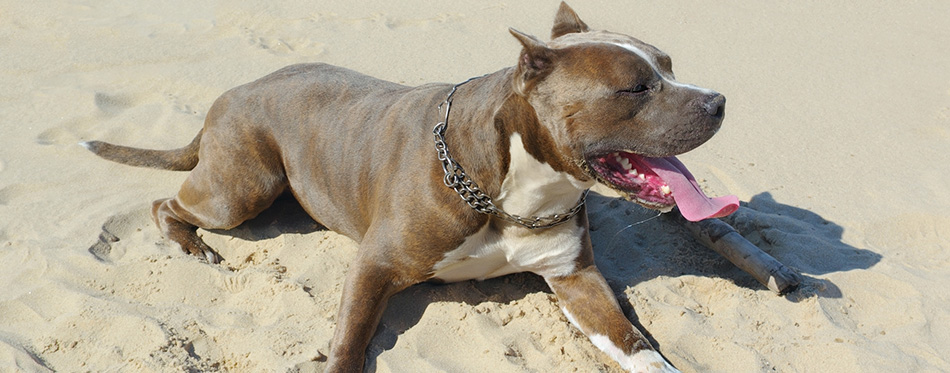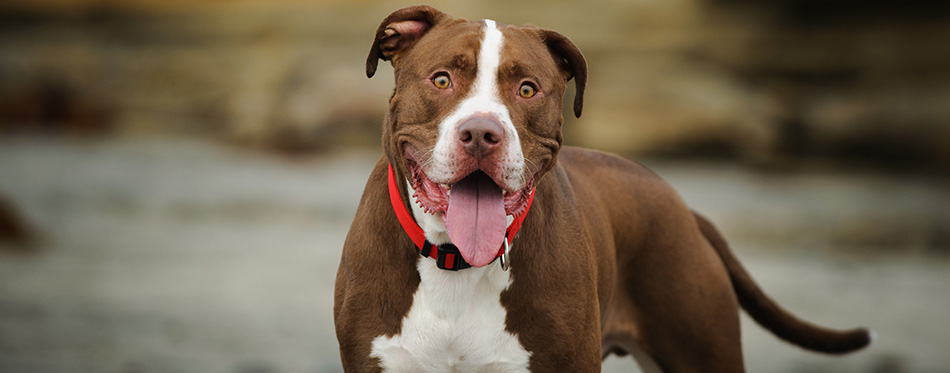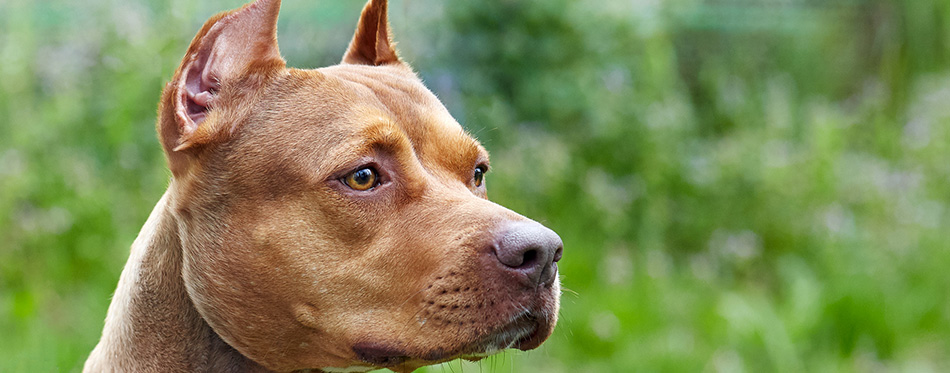Just when you thought you could easily identify an American Pit Bull Terrier (APBT), now comes a dog that has all the characteristics of the formidable companion, except that it sports a red nose, red coat, amber eyes, and red toenails. Yes, the Red Nose Pitbull (RNP) IS an American Pit Bull Terrier. However, it’s not really a new subspecies or a new type of the APBT. As a matter of fact, it is one of the oldest of the bull-and-terrier dogs of the British Isles that eventually found its way into the US. That being said, getting an RNP is just like getting any other APBT in your life. But given the magnificence of its color, the Red Nose Pitbull is sure to turn heads.

History of the Red Nose Pitbull
The Red Nose Pitbull traces its origins to mid-19th century Ireland. Prior to this, the British were very fond of bloodsports that featured bears and bulls. It’s believed to be a carryover from the popular Roman pastime of gladiator games in coliseums. Of course, no one would dare pit man against man in a no-holds-barred contest anymore so people, out of the intense desire to carry on with tradition, opted for using animals instead.
Bloodsport enthusiasts required a strong, athletic, agile, and game dog that will sink its teeth into the flesh of bears or bulls until the beast is felled in the center of the arena. For this, 18th to 19th century folks bred the Old English Terrier with the Old English Bulldog to create the Bull-and-Terrier dog. This is undoubtedly the direct ancestor of the modern-day APBT.
At about the same time, one specific strain or bloodline of Bull-and-Terrier dogs was developed in Ireland. This bloodline was called the Old Family. What separated them from other Bull-and-Terrier breeders was that the Irish breeders observed very strict inbreeding practices so that the unique characteristics – especially the dog’s color – is preserved and maintained. These dogs were eventually called the Irish Old Family Reds, owing to the recessive nature of the color red. The Irish Old Family Reds are the direct ancestors of the modern Red Nose Pitbull.
Sometime in the last quarter of the 19th century, these Old Family Reds found their way to the US courtesy of Irish immigrants. It was then that they were called the Red Nose Pitbulls.
Do take note that despite its name, it’s not only the nose of the dog that has a reddish hue. The eyes, coat, lips, and toenails are also colored red or have a reddish hue in either copper or amber.
Not all dogs with reddish physical attributes can be considered to be Red Nose Pitbulls, however. For it to be classified as such, thorough genealogy should show that it has an extensive network of ancestors that are purebred Irish Old Family Reds. This means that 90 to 95 percent of its bloodline should come from an Irish Old Family Red.
This is to counter the highly prevalent crossbreeding of the Old Family Red Nose (OFRN) with other pitbulls, resulting in a significant reduction in the dog’s gameness and unique reddish colorings. Just because it has a red nose doesn’t mean it is a true Red Nose Pitbull. As such, when getting an RNP it is imperative to look at its family tree.
Quick Facts
While Red Nose Pitbulls are a special kind of American Pit Bull Terrier, they do possess some very unique characteristics that make them what they really are. As such, whenever you’re entertaining on getting a Red Nose Pitbull make sure you check on these facts.
- The nose should have a copper-red color.
- The eyes should be either amber or red in color.
- The lips, tail, and toenails should be reddish.
- The coat should also be reddish, although cream or white patches may be found on its toes and chest. However, a greater proportion of its body should have a distinct reddish color.
- It is typically larger than your conventional American Pit Bull Terrier. APBTs can weigh about 30 to 60 lbs. The Red Nose Pitbull, on the other hand, can tip the scale at 35 to 65 lbs. There are also documents that show the Red Nose Pitbull can be as heavy as 80 lbs.
- The Red Nose Pitbull can have a height of 18 to 22 inches while the average APBT comes in at 17 to 21 inches.
Things You Should Know
We’ve got to say that the Red Nose Pitbull is one magnificent-looking American Pit Bull Terrier. Unfortunately, it’s not for everyone. No thanks to unscrupulous Pitbull owners and the media, the Red Nose Pitbull suffers the same stigma that has befallen other APBTs. But if you’re really intent on making this YOUR dog, then get ready for the following.
Training
All dogs need to be trained. Period. We couldn’t make ourselves clearer than that. But for the Red Nose Pitbull, it requires a special kind of person to train it. No, we’re not talking about the strict, rod-wielding, punishment-oriented disciplinarian-slash-dog owner-slash-trainer. We’re talking about someone who has the guts to tame the bear-baiting and bull-baiting dog inside the Red Nose Pitbull. We’re also talking about someone who is a true believer of the role of the pack leader, the Alpha who takes good care of its brood; the same person who can exercise restraint and firmness when needed and absolute gentleness and compassion in every aspect of the training.
We’re talking about training a dog that has been bred, right from the start, to fight. We’re looking for a potential dog owner who has all the qualities of a reliable individual who can turn this fighting beast into a tame, inspiring, adorable, lovable, obedient, and affectionate hound for everyone without having to resort to harsh tactics, use prong and shock collars, or any other aversive methods of dog training.
The Red Nose Pitbull, like all APBTs, has endured a lot of negativity and criticisms thrown its way. The last thing it needs is someone who will only further cement such bad reputation into the consciousness of others. So, before we proceed with the other things you need to know about this dog, you’ve got to ask yourself now whether you’ve got what it takes to train the Red Nose Pitbull the correct way. If you answer in the affirmative, then congratulations. If not, then still congratulate yourself for recognizing your limitations and for allowing the Red Nose Pitbull to be trained by someone who has what it takes to be the master of this canine.
APBTs are intelligent and the Red Nose Pitbull is no different. They are very easy to train, but only if you know how to properly motivate them. It needs someone to look up to without getting hurt or punished in the process.
Related Post: Dog Training Books
Feeding
Don’t ever skimp on high-quality, high-protein dog food for the Red Nose Pitbull. If you want it to retain its well-chiseled muscles, then you’ve got to get only the best in terms of animal proteins. Skip so-called plant proteins. As long as you give high-quality, novel, easily-digestible, and named animal proteins, you’re doing the Red Nose Pittie some good. It’s okay to give carbs, but stick with low glycemic foods, high-fiber ingredients, and antioxidant-rich veggies and fruits. Be mindful of allergenic cereals since Pitbulls are quite notorious for food sensitivities. For a wider selection of choices, check out our dog food for pitbulls guide.
The Red Nose Pitbull will also benefit from a diet that is rich in chondroitin, glucosamine, phosphorus, and calcium as it may be a bit more prone to joint problems. It is also best to give dog food that contains the omega-3 fatty acids DHA and EPA to help improve cardiac function and eye and brain health.
As always, we don’t advise you to stick with ‘cup’ measurements. Instead, try to learn how to compute for the dog’s daily caloric needs. Simply get its weight in kilograms and then raise this to the power of 0.75. Multiply the result by 70 and you already have an idea about the dog’s baseline or resting energy requirement. Of course, you’ve got to factor in the dog’s activity level and life stage. As such, a 60-lb unneutered male will require about 1,500 to 1,600 calories, divided into 2-3 meals.
For more guides on choosing the right dog food, you may wish to check out our reviews of the best dry dog food, organic dog food, grain free dog food, senior dog food and dog food toppers.

Exercise
The Red Nose Pitbull, like its APBT brethren, requires lots of exercise. Those muscles on its body need to be strengthened and toned so they don’t shrink or atrophy and cause various problems. It also needs plenty of space to run about and play with your kids which the dog adores. It can stay in your apartment, why not? However, it’s a must that you take it for its daily walk for a minimum of 60 minutes twice daily. You can also bring it to the dog park or some other open space where you can play Frisbee, fetch, or any other playtime activity. Head over to our review of dog frisbees for more alternatives.
It loves puzzles, too. Using puzzle feeders can also help temper its tendency to become overweight. It’s a form of mental stimulation as well. You don’t want a Red Nose Pitbull to ever feel bored in your house. You’ll instantly know it’s bored if you arrive home one day only to discover your house is in complete disarray like a Cat 5 tornado just roared through.
Socialization
Just as training is important in the life of a Red Nose Pitbull, so is socialization. The reason why most people think the APBT is an aggressive dog is that the owners of these dogs never socialized them early enough. Keep in mind that the APBT was specifically bred for bull-baiting and bear-baiting in bloodsport events. Even though it is faced with a fellow dog, its instincts can still kick in.
But if you’re looking for some inspiration on how this can be done, just look at Cesar Millan’s Junior. It’s an APBT, yet its demeanor is nothing like the aggressive dog painted by the media. It’s so gentle and friendly that problematic dogs in the show are the ones that are being aggressive towards Junior. We’re not marketing the show; we just think it’s the perfect example of how a well-socialized APBT can be such a darling even in the face of adversity.
Known as ‘nanny dogs’, the Red Nose Pitbull is excellent with kids. They look at these ‘little people’ as very fragile and, as such, will do anything to protect them from danger. They’re very patient with kids. They don’t snap or bite. However, it’s imperative that you supervise since your kid might also hurt the dog.
Grooming
This is an area where you’ll never have to fret. Its short hair means less frequent combing and brushing. However, once weekly grooming is required to remove dirt from its coat, distribute the oils on its skin, and improve overall circulation. You don’t even have to bathe the Red Nose Pitbull very often; once or twice a year should be okay.
Cleaning its ears is required on a more frequent basis, however. Once or twice weekly is enough. Daily dental care is ideal, although twice a week is just fine. Clipping or trimming the nails should be done on a monthly basis.
For more help on dog grooming, you may wish to read our guides on the best dog nail grinders, dog dryers, dog clippers, dog paw washers and dog shampoo.
Health
While the Red Nose Pitbull has a robust appearance, it’s never really safe from diseases. Hip dysplasia is a very common occurrence, as are other joint problems. There may also be issues with the eyes and the heart. Allergies are also quite common.
The Red Nose Pitbull is ideal for…
- Folks with extensive experience caring for ‘challenging’ dogs
- Individuals who have an Alpha personality, yet with gentleness and compassion to oversee the correct training and socialization of the Red Nose Pitbull
- Families with young kids, provided enough supervision and kids’ education on proper pet handling is observed
- Those with access to large open spaces for exercise and playtime needs
- Individuals who understand the unique needs of the APBT in general and the Red Nose Pitbull in particular
Forget the Red Nose Pitbull if you…
- Will use punishment and other harsh methods to train your dog
- Are intent on creating an aggressive dog
- Cannot commit to proper and early socialization
Temperament
The Red Nose Pitbull shares its temperament with the American Pit Bull Terrier, being bloodline or strain of the APBT. As such, like any other APBT, the Red Nose Pitbull also has a very gentle and mild-mannered temperament. Sadly, it is always depicted in the media as a blood-lusting aggressor, fully capable of latching its teeth onto hapless victims.
We can always thank the media and self-serving news reporting about the bad reputation of the APBT and its bloodlines like the Red Nose Pitbull. And while we truly appreciate the efforts of celebrities in increasing the level of awareness of the public regarding the sweet and gentle nature of the American Pit Bull Terrier, it is not really enough to change public perception about the breed. We can only hope that through this resource you’d learn more about the APBT and the Red Nose Pitbull and help spread the correct knowledge about this dog.

The Red Nose Pitbull, like all well-trained APBTs, is known for its passion for life. It’s a confident breed that will never back down from a fight if its family is threatened. It is a protector, a guardian, and a very loyal companion for the whole family. It embodies the virtues of a great warrior – gentle and affectionate to those it considers as belonging to its pack and courageous, brave, and fearsome to those who dare disrupt the harmony and peace of its family.
It has the playfulness and gameness of terriers that make them excellent playmates for children. They are very keen on pleasing their owners, whether it is the adults or the kids. Given a task, they’d readily give their all.
Contrary to what news organizations and media outfits want you to believe, Red Nose Pitbulls and APBTs in general don’t attack. Sure, they may be aggressive, but this is only because their owners never really tried training and socializing them. A good dog can turn bad in the hands of a bad person. Remember this.
The American Temperament Test Society rated the APBT at 87.4%, meaning they are more even-tempered than the German Shepherd (85.3%), the Golden Retriever (85.6%), and the Beagle (79.7%). It has almost the same temperament as the Chesapeake Bay Retriever (87.8%) and the Newfoundland (87.5%). It’s also not really far behind the temperament of the Labrador Retriever at 92.2% and the Belgian Malinois at 94.1%.
We’re never really a fan of Cesar Millan, but we cannot help but admire the temperament of his APBTs especially Daddy, now Junior. Whenever a hapless dog owner requires some form of doggie behavior assistance, Daddy and Junior are always there to guide. We have never seen them show any form of aggression towards any of the dogs they have met. As a matter of fact, it was always the other way around. It was other dogs that were quite aggressive towards the APBTs of Millan. We have to really highlight this because it just shows what we have firmly believed so far – the APBT is a mild-mannered, even-tempered dog in the hands of a capable, firm yet trusting dog owner.
The Red Nose Pitbull is an adorable dog that is desperately trying to shed its negative image as an aggressor. Only committed individuals who understand how it feels like to be typecast and who is willing to do everything to change the perception of others about this dog can become the true owner of a Red Nose Pitbull.

